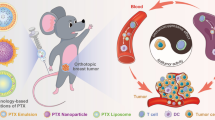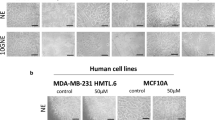Abstract
Purpose
To overcome the drawbacks of high dose regimen and improve the outcomes of chemotherapy at a low dose, an immunotherapeutic nanoemulsion based combination of chemotherapeutic agent (paclitaxel) with immunomodulatory agent (vitamin E) was developed and evaluated for their antitumor effect against breast cancer.
Methods
A total of five nanoemulsions loaded with various content of vitamin E were prepared and characterized. The immunoregulatory effects of vitamin E along with the overall antitumor efficacy of vitamin E-rich nanoemulsion with a low dose of paclitaxel were investigated through in vitro and in vivo experiments.
Results
Vitamin E-rich nanoemulsion exhibited relatively narrow size distribution, high entrapment efficiency and controlled in vitro release profile. In RAW264.7 cells, vitamin E-rich nanoemulsion significantly enhanced the secretion of Th1 cytokines and down-regulated the secretion of Th2 cytokine. In a co-culture system, vitamin E-rich nanoemulsion induced a high apoptosis rate in MDA-MB-231 cells as compared with vitamin E-low nanoemulsion. Furthermore, vitamin E-rich nanoemulsion exhibited superior in vivo antitumor efficacy in comparison with Taxol and vitamin E-low nanoemulsion at a paclitaxel dose of 4 mg/kg.
Conclusions
Vitamin E-rich nanoemulsion has great potential for the treatment of breast cancers with a low dose of paclitaxel via driving Th1 immune response.







Similar content being viewed by others
Abbreviations
- CFDA-SE:
-
Carboxyfluorescein diacetate succinimidyl ester
- EE:
-
Entrapment efficiency
- ELISA:
-
Enzyme-linked immunosorbent assay
- E:T:
-
Effector cells: target cells
- HPLC:
-
High performance liquid chromatography
- IFN-γ:
-
Interferon γ
- IL-10:
-
Interleukin 10
- IL-12:
-
Interleukin 12
- LDLR:
-
Low-density lipoprotein receptor
- MTD:
-
Maximum tolerated dose
- PBS:
-
Phosphate buffer solution
- PDI:
-
Polydispersity index
- PI:
-
Propidium iodide
- PTX:
-
Paclitaxel
- Th1:
-
T helper 1
- Th2:
-
T helper 2
- VE:
-
Vitamin E
References
Chen W, Zheng R, Baade PD, Zhang S, Zeng H, Bray F, Jemal A, Yu XQ, He J. Cancer statistics in China, 2015. CA Cancer J Clin. 2016;66(2):115–32.
Qiao J, Liu Z, Fu YX. Adapting conventional cancer treatment for immunotherapy. J Mol Med. 2016;94(5):489–95.
Landreneau JP, Shurin MR, Agassandian MV, Keskinov AA, Ma Y, Shurin GV. Immunological mechanisms of low and ultra-low dose cancer chemotherapy. Cancer Microenviron: Off J Int Cancer Microenviron Soc. 2015;8(2):57–64.
Zheng Y, Dou Y, Duan L, Cong C, Gao A, Lai Q, Sun Y. Using chemo-drugs or irradiation to break immune tolerance and facilitate immunotherapy in solid cancer. Cell Immunol. 2015;294(1):54–9.
Tao Y, Ju E, Liu Z, Dong K, Ren J, Qu X. Engineered, self-assembled near-infrared photothermal agents for combined tumor immunotherapy and chemo-photothermal therapy. Biomaterials. 2014;35(24):6646–56.
Roy A, Singh MS, Upadhyay P, Bhaskar S. Nanoparticle mediated co-delivery of paclitaxel and a TLR-4 agonist results in tumor regression and enhanced immune response in the tumor microenvironment of a mouse model. Int J Pharm. 2013;445(1–2):171–80.
Seth A, Heo MB, Lim YT. Poly (gamma-glutamic acid) based combination of water-insoluble paclitaxel and TLR7 agonist for chemo-immunotherapy. Biomaterials. 2014;35(27):7992–8001.
Lollo G, Vincent M, Ullio-Gamboa G, Lemaire L, Franconi F, Couez D, Benoit JP. Development of multifunctional lipid nanocapsules for the co-delivery of paclitaxel and CpG-ODN in the treatment of glioblastoma. Int J Pharm. 2015;495(2):972–80.
Ramakrishnan R, Gabrilovich DI. Novel mechanism of synergistic effects of conventional chemotherapy and immune therapy of cancer. Cancer Immunol, Immunotherapy: CII. 2013;62(3):405–10.
Emens LA, Middleton G. The interplay of immunotherapy and chemotherapy: harnessing potential synergies. Cancer Immunol Res. 2015;3(5):436–43.
Cook AM, Lesterhuis WJ, Nowak AK, Lake RA. Chemotherapy and immunotherapy: mapping the road ahead. Curr Opin Immunol. 2016;39:23–9.
Pawar VK, Panchal SB, Singh Y, Meher JG, Sharma K, Singh P, Bora HK, Singh A, Datta D, Chourasia MK. Immunotherapeutic vitamin E nanoemulsion synergies the antiproliferative activity of paclitaxel in breast cancer cells via modulating Th1 and Th2 immune response. J Control Release: Off J Control Release Soc. 2014;196:295–306.
Kang TH, Knoff J, Yeh WH, Yang B, Wang C, Kim YS, Kim TW, Wu TC, Hung CF. Treatment of tumors with vitamin E suppresses myeloid derived suppressor cells and enhances CD8+ T cell-mediated antitumor effects. PLoS One. 2014;9(7):e103562.
Radhakrishnan AK, Mahalingam D, Selvaduray KR, Nesaretnam K. Supplementation with natural forms of vitamin E augments antigen-specific TH1-type immune response to tetanus toxoid. Biomed Res Int. 2013;2013:782067.
Sharma M, Sehgal R, Kaur S. Evaluation of nephroprotective and immunomodulatory activities of antioxidants in combination with cisplatin against murine visceral leishmaniasis. PLoS Negl Trop Dis. 2012;6(5):e1629.
Hernandez J, Soto-Canevett E, Pinelli-Saavedra A, Resendiz M, Moya-Camarena SY, Klasing KC. In vitro effect of vitamin E on lectin-stimulated porcine peripheral blood mononuclear cells. Vet Immunol Immunopathol. 2009;131(1–2):9–16.
Han SN, Adolfsson O, Lee CK, Prolla TA, Ordovas J, Meydani SN. Age and vitamin E-induced changes in gene expression profiles of T cells. J Immunol. 2006;177(9):6052–61.
Malmberg KJ, Lenkei R, Petersson M, Ohlum T, Ichihara F, Glimelius B, Frodin JE, Masucci G, Kiessling R. A short-term dietary supplementation of high doses of vitamin E increases T helper 1 cytokine production in patients with advanced colorectal cancer. Clin Cancer Res: Off J Am Assoc Cancer Res. 2002;8(6):1772–8.
Han SN, Wu D, Ha WK, Beharka A, Smith DE, Bender BS, Meydani SN. Vitamin E supplementation increases T helper 1 cytokine production in old mice infected with influenza virus. Immunology. 2000;100(4):487–93.
Jeng KC, Yang CS, Siu WY, Tsai YS, Liao WJ, Kuo JS. Supplementation with vitamins C and E enhances cytokine production by peripheral blood mononuclear cells in healthy adults. Am J Clin Nutr. 1996;64(6):960–5.
Tanaka J, Fujiwara H, Torisu M. Vitamin E and immune response. I. Enhancement of helper T cell activity by dietary supplementation of vitamin E in mice. Immunology. 1979;38(4):727–34.
Nishimura T, Nakui M, Sato M, Iwakabe K, Kitamura H, Sekimoto M, Ohta A, Koda T, Nishimura S. The critical role of Th1-dominant immunity in tumor immunology. Cancer Chemother Pharmacol. 2000;46(1):S52–61.
Singla AK, Garg A, Aggarwal D. Paclitaxel and its formulations. Int J Pharm. 2002;235(1–2):179–92.
Hormann K, Zimmer A. Drug delivery and drug targeting with parenteral lipid nanoemulsions - a review. J Control Release: Off J Control Release Soc. 2016;223:85–98.
Najlah M, Kadam A, Wan KW, Ahmed W, Taylor KM, Elhissi AM. Novel paclitaxel formulations solubilized by parenteral nutrition nanoemulsions for application against glioma cell lines. Int J Pharm. 2016;506(1–2):102–9.
Ye J, Liu Y, Xia X, Meng L, Dong W, Wang R, Fu Z, Liu H, Han R. Improved safety and efficacy of a lipid emulsion loaded with a paclitaxel-cholesterol complex for the treatment of breast tumors. Oncol Rep. 2016a;36(1):399–409.
Xia XJ, Guo RF, Liu YL, Zhang PX, Zhou CP, Jin DJ, Wang RY. Formulation, characterization and hypersensitivity evaluation of an intravenous emulsion loaded with a paclitaxel-cholesterol complex. Chem Pharm Bull. 2011;59(3):321–6.
Ye J, Xia X, Dong W, Hao H, Meng L, Yang Y, Wang R, Lyu Y, Liu Y. Cellular uptake mechanism and comparative evaluation of antineoplastic effects of paclitaxel– cholesterol lipid emulsion on triple-negative and non-triple-negative breast cancer cell lines. Int J Nanomedicine. 2016b;11:4125–40.
Nava G, Pinon E, Mendoza L, Mendoza N, Quintanar D, Ganem A. Formulation and in Vitro, ex vivo and in Vivo evaluation of elastic liposomes for transdermal delivery of ketorolac Tromethamine. Pharmaceutics. 2011;3(4):954–70.
Chidambaram N, Burgess DJ. A novel in vitro release method for submicron sized dispersed systems. AAPS PharmSci. 1999;1(3):E11.
Jing X, Deng L, Gao B, Xiao L, Zhang Y, Ke X, Lian J, Zhao Q, Ma L, Yao J, Chen J. A novel polyethylene glycol mediated lipid nanoemulsion as drug delivery carrier for paclitaxel. Nanomedicine: Nnanotechnol, Biol, Med. 2014;10(2):371–80.
Wang XQ, Duan XM, Liu LH, Fang YQ, Tan Y. Carboxyfluorescein diacetate succinimidyl ester fluorescent dye for cell labeling. Acta Biochim Biophys Sin. 2005;37(6):379–85.
Liu D, Yu J, Chen H, Reichman R, Wu H, Jin X. Statistical determination of threshold for cellular division in the CFSE-labeling assay. J Immunol Methods. 2006;312(1–2):126–36.
Roy A, Chandra S, Mamilapally S, Upadhyay P, Bhaskar S. Anticancer and immunostimulatory activity by conjugate of paclitaxel and non-toxic derivative of LPS for combined chemo-immunotherapy. Pharm Res. 2012;29(8):2294–309.
Tan PH, Sagoo P, Chan C, Yates JB, Campbell J, Beutelspacher SC, Foxwell BMJ, Lombardi G, George AJT. Inhibition of NF- B and oxidative pathways in human dendritic cells by Antioxidative vitamins generates regulatory T cells. J Immunol. 2005;174(12):7633–44.
Walstra P. Principles of emulsion formation. Chem Eng Sci. 1993;48(2):333–49.
Zhang Y, Tan C, Abbas S, Eric K, Xia S, Zhang X. Modified SPI improves the emulsion properties and oxidative stability of fish oil microcapsules. Food Hydrocoll. 2015;51:108–17.
Mosmann TR, Sad S. The expanding universe of T-cell subsets: Th1, Th2 and more. Immunol Today. 1996;17(3):138–46.
Wang Y, Huang DS, Eskelson CD, Watson RR. Long-term dietary vitamin E retards development of retrovirus-induced disregulation in cytokine production. Clin Immunol Immunopathol. 1994;72(1):70–5.
Trinchieri G. Cytokines acting on or secreted by macrophages during intracellular infection (IL-10, IL-12, IFN-gamma). Curr Opin Immunol. 1997;9(1):17–23.
Shankaran V, Ikeda H, Bruce AT, White JM, Swanson PE, Old LJ, Schreiber RD. IFNgamma and lymphocytes prevent primary tumour development and shape tumour immunogenicity. Nature. 2001;410(6832):1107–11.
He Q, Li J, Yin W, Song Z, Zhang Z, Yi T, Tang J, Wu D, Lu Y, Wang Z, Liu D, Zhang X, Hu Z, Gao J. Low-dose paclitaxel enhances the anti-tumor efficacy of GM-CSF surface-modified whole-tumor-cell vaccine in mouse model of prostate cancer. Cancer Immunol Immunother. 2011;60(5):715–30.
Acknowledgments and Disclosures
This work was financially supported by the National Natural Science Foundation of China (No. 81402874) and the Beijing Natural Science Foundation of China (No. 7162135). The authors report no conflicts of interest in this work.
Author information
Authors and Affiliations
Corresponding author
Additional information
Jun Ye and Wujun Dong contributed equally to this work.
Electronic supplementary material
Figure S1
The stability of nanoemulsions was monitored at 4°C for 9 months. (a) Particle size and polydispersity index (PDI) of nanoemulsions loaded with paclitaxel and variant content of vitamin E (0.01%, 2.4%, 4.8%, 7.2%, and 10%, w/v). (b) Particle size distribution and standard deviation of nanoemulsions determined by the Zeta Potential/Particle Sizer NICOMP 380 ZLS (PSS NICOMP, Santa Barbara, CA, USA). (GIF 37 kb)
Figure S2
In vivo tumor growth inhibition (a) and body weight changes (b) of 4T1 tumor-bearing BALB/c nude mice after intravenous treatment of mice with Taxol, 0.01%VE, or 7.2%VE at the dose of 4 mg/kg PTX. (c) Representative images of excised tumors from different groups at the end of the experiment. a, 7.2%VE vs. Control, p < 0.01; b, 7.2%VE vs. Taxol, p < 0.01; c, 0.01%VE vs. Control, p < 0.01; d, 0.01%VE vs. Taxol, p < 0.01; e, 7.2%VE vs. 0.01%VE, p > 0.05. (GIF 91.1 kb)
Rights and permissions
About this article
Cite this article
Ye, J., Dong, W., Yang, Y. et al. Vitamin E-rich Nanoemulsion Enhances the Antitumor Efficacy of Low-Dose Paclitaxel by Driving Th1 Immune Response. Pharm Res 34, 1244–1254 (2017). https://doi.org/10.1007/s11095-017-2141-3
Received:
Accepted:
Published:
Issue Date:
DOI: https://doi.org/10.1007/s11095-017-2141-3




